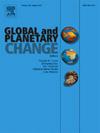A half-century drying in Gobi Oasis, possible role of ENSO and warming/moistening of Northwest China
IF 4
1区 地球科学
Q1 GEOGRAPHY, PHYSICAL
引用次数: 0
Abstract
To investigate the historical wet/dry fluctuations in Gobi Oasis and its driving mechanism under the background of global warming, a climatological study of tree-ring stable oxygen isotope (δ18O) was carried out in the Gobi Oasis in northwest China. Based on the tree-ring δ18O sequence of Populus euphratica, the 124-year (1886–2009) June–August relative humidity history of the oasis was reconstructed, explaining 49.2 % of the total variance of the meteorological observation during 1960–2009. The reconstructed sequence captured the changing characteristics of the relative humidity in the oasis in summer and showed that the wet years in the past 124 years mainly occurred before 1950s, while the relative humidity showed a continuous downward trend after 1950s. The spatial correlation shows that the reconstructed summer relative humidity has good spatial representation and can reflect the large-scale relative humidity variations in Northwestern China from June to August, and is consistent with other paleoclimate reconstructions in adjacent areas. The comparison found that the reconstructed sequence was significantly correlated with the dry-wet indices in the westerlies region at both high and low frequencies, and was significantly correlated with the reconstructions in the monsoon region at low frequency, which imply that the relative humidity in the oasis in summer might be affected by both the westerlies and the East Asian summer monsoon. In addition, we found that the changes in summer relative humidity in the oasis were related to large-scale air-sea interactions. The El Niño-Southern Oscillation (ENSO) in the central Pacific was the main influencing factor.
戈壁绿洲半个世纪的干旱:ENSO与西北增温增湿的可能作用
为探讨全球变暖背景下戈壁绿洲干湿变化的历史特征及其驱动机制,对中国西北戈壁绿洲进行了树轮稳定氧同位素(δ18O)的气候学研究。利用胡杨树轮δ18O序列,重建了该绿洲124年(1886-2009年)6 - 8月相对湿度变化历史,对1960-2009年气象观测总方差的贡献率为49.2%。重建序列捕捉到了绿洲夏季相对湿度的变化特征,表明近124 a湿润年主要发生在50年代以前,50年代以后相对湿度呈持续下降趋势。空间相关性表明,重建的夏季相对湿度具有较好的空间代表性,能够反映西北地区6 ~ 8月的大尺度相对湿度变化,与邻近地区的其他古气候重建结果一致。对比发现,重建序列在高、低频与西风区干湿指数显著相关,在低频与季风区干湿指数显著相关,说明绿洲夏季相对湿度可能同时受到西风区和东亚夏季风的影响。此外,绿洲夏季相对湿度的变化与大尺度的海气相互作用有关。中太平洋El Niño-Southern涛动(ENSO)是主要影响因素。
本文章由计算机程序翻译,如有差异,请以英文原文为准。
求助全文
约1分钟内获得全文
求助全文
来源期刊

Global and Planetary Change
地学天文-地球科学综合
CiteScore
7.40
自引率
10.30%
发文量
226
审稿时长
63 days
期刊介绍:
The objective of the journal Global and Planetary Change is to provide a multi-disciplinary overview of the processes taking place in the Earth System and involved in planetary change over time. The journal focuses on records of the past and current state of the earth system, and future scenarios , and their link to global environmental change. Regional or process-oriented studies are welcome if they discuss global implications. Topics include, but are not limited to, changes in the dynamics and composition of the atmosphere, oceans and cryosphere, as well as climate change, sea level variation, observations/modelling of Earth processes from deep to (near-)surface and their coupling, global ecology, biogeography and the resilience/thresholds in ecosystems.
Key criteria for the consideration of manuscripts are (a) the relevance for the global scientific community and/or (b) the wider implications for global scale problems, preferably combined with (c) having a significance beyond a single discipline. A clear focus on key processes associated with planetary scale change is strongly encouraged.
Manuscripts can be submitted as either research contributions or as a review article. Every effort should be made towards the presentation of research outcomes in an understandable way for a broad readership.
 求助内容:
求助内容: 应助结果提醒方式:
应助结果提醒方式:


